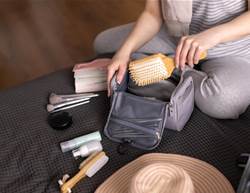It's one thing to be klutzy, and everybody has endured their fair share of embarrassing moments. But when you get older, nobody's laughing about balance-falling is one of the most serious medical problems facing old people.
In fact, balance is a crucial survival skill, but it's also perishable. The muscles we use to stand tall weaken ever so gradually after we hit 30 (yes, only 30). The length of our stride shortens, the pace of our steps slows, and vision-critical to coordination-becomes fuzzier. Even menopause can make our gait a tad more wobbly. "Ageing, however, isn't the only reason people lose their sense of stability," says physical therapist Lynn Millar. "Balance is really 'use it or lose it.' You can maintain it if you stay active."
How well we keep our balance in midlife can protect us from what lies ahead: One in three adults over age 65 takes a serious tumble each year. Avoiding falls means a longer life: About 20% of women who fracture a hip become permanently disabled, and another 20% die within a year. In fact, health problems linked to hip fractures result in more women's deaths each year than breast cancer does.
But an enhanced sense of stability doesn't just help protect you from future falls. There are immediate health benefits-better mobility, fewer injuries, greater capacity to push yourself harder during workouts-that increase overall fitness, says exercise physiologist Fabio Comana.
The problem is that people are often unaware that their coordination is slipping. While there are hallmarks of clumsiness-such as poor handwriting and constantly banged-up shins and knees-even naturally agile people need to work to boost balance with age. "Balance is a separate system, just like strength or flexibility. You can improve it if you continue to challenge it," says sports medicine expert Dr Edward Laskowski.
Here are eight strategies to help strengthen the core and lower-body muscles that keep you steady on your feet.
Stand on one leg
Try to do this while you are washing the dishes, suggests Laskowski. When you can hold the pose for 30 seconds on each side, stand on a less stable surface, such as a couch cushion; to increase the challenge even more, do it with your eyes closed.
Balance on a wobble board
It's one of a few gym gizmos designed to challenge your stability. Participants in one study improved with three training sessions a week, each just 6 minutes long. Here's how to do it: Stand on the board, feet shoulder-width apart, abs tight, and rock forward and back and side to side for a minute at a time. (Hold a chair for support, if needed.) Work up to 2 minutes, without holding on or letting the edges of the device touch the floor. "Keep injecting novelty into your routine," says Millar. "Push yourself to try something new, and you'll boost both balance and overall health."
Take a tai chi class
A study of tai chi practitioners in their mid-60s found that on measures of stability. Additionally, a review of 18 trials including nearly 4,000 participants found that people participating in tai chi were less likely to fall than those who took part in basic stretching programs or made lifestyle changes. Yoga works, too: According to Temple University research, women 65 and older who took twice-weekly yoga classes for 9 weeks increased ankle flexibility and showed more confidence in walking. That last part is important, says lead researcher Dr Jinsup Song, "because when people are fearful of losing balance, they tend to do less to challenge themselves." That fear doesn't plague only the elderly: A Howard University study found that among those 65 and older, 22% had already become fearful of falling.
Walk heel to toe
The same sobriety field test cops give drunk drivers also improves balance. Take 20 steps forward, heel to toe. Then walk backward, with toe to heel, in a straight line.
Do squats
Sturdy legs can help prevent a stumble from turning into a fall, says Comana. To build quads, start with a simple squat: With feet hip-width apart, bend knees and hips and slowly lower yourself as if sitting in a chair behind you. Keep arms straight out, abs tight, back straight, and knees above shoelaces. Stop when thighs are parallel to the floor (or as close as you can get), then contract glutes as you stand back up. Aim for 3 sets of 10, with a 1-minute break after each set.
Practice the force
It takes muscle strength to get out of a chair, but it takes muscle force to do it quickly. "That force-the ability to get your leg in the right place in a nanosecond-is important in preventing falls," says Comana. We lose muscle force faster than strength, and according to new research, it takes older women longer to build it back up. Try this move: Instead of gingerly rising from a chair, once in a while leap out of it so forcefully that you need to take a few running steps after you do so. (You can use your arms to gain momentum.) "The explosiveness of that action builds power," says Comana. Side-to-side and back-to-front muscle movements have the same effect, such as when you play tennis or basketball.
Take up ballet
When researchers measured muscle movements of a group of professional ballet dancers against those of people who had no ballet or gymnastics training, they found the ballet dancers moved with greater precision and grace. Not too surprising, right? What was surprising, to researchers at least, was the reason ballet dancers balanced better. The dancers used more muscle groups, even just when walking across a flat floor, than people who had no training. That indicates that dance training strengthens your nervous system's ability to coordinate muscle groups so you keep your balance.
Get a good night's rest
Sleep more than 7 hours a night. Sleep deprivation slows reaction time, and a study at California Pacific Medical Center shows that it's also directly related to falls. Researchers tracked nearly 3,000 older women and found that those who typically slept between 5 and 7 hours each night were 40% more likely to fall than those who slept longer.
Test Your Balance
Try these three moves to see how well you can balance.
- On both feet: Stand with feet together, anklebones touching, and arms folded across chest; then close your eyes. Have someone time you: Though it's normal to sway a little, you should be able to stand for 60 seconds without moving your feet. Next, place one foot directly in front of the other and close your eyes. You should be able to stand for at least 38 seconds on both sides.
- On one foot: Stand on one foot and bend other knee, lifting nonsupporting foot off floor without letting it touch standing leg. (Do this in a doorway so you can grab the sides if you start to fall.) Repeat with eyes closed. People age 60 and younger can typically hold the pose for about 29 seconds with their eyes open, 21 seconds with their eyes closed. People age 61 and older: 22 seconds with eyes open, 10 seconds with eyes closed.
- On ball of foot: Stand on one foot with hands on hips, and place nonsupporting foot against inside knee of standing leg. Raise heel off floor and hold the pose-you should be able to do so for 25 seconds.










